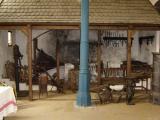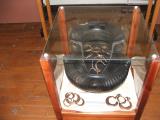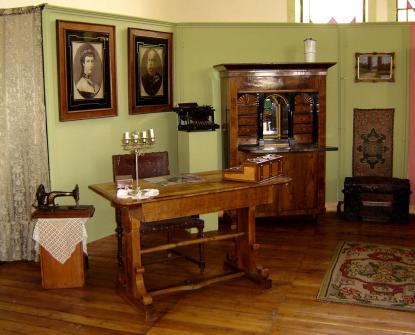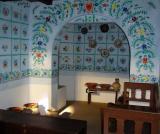2024. April 19. Friday
Rétközi Museum - Kisvárda
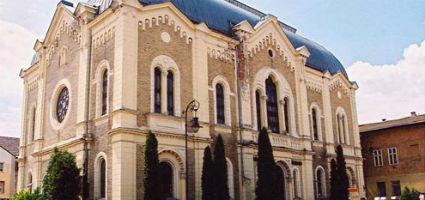 |
Address: 4600, Kisvárda Csillag u. 5.
Phone number: (45) 405-154, (70) 342-0774
E-mail: retkozi@kisvarda.hu
Opening hours: 01.04-15.10.: Tue-Sat 8:30-16:30, Sun 8:30-14:30
|
In the 14th and 15th centuries, Kisvárda was the property of the Várdai family, several of whose members held high religious and secular office. The town lay at the junction of roads linking Munkács, Beregszász, and Szatmár, by way of the Tisza bend, with Királyhelmec, Kassa, and the towns and mining centers of the Szepesség. These transportation links explain why Kisvárda served as an important commercial center.
It was the Esterházy family that gave permission to Jews to settle in the town. Sources indicate that in 1747 one solitary Jew lived in Kisvárda. By 1784-85, the community counted some 118 members, a not inconsiderable number by the standards of the times. (In 1851, Jews accounted for around 22.5 percent of the population, and in 1910, for 30.2 percent.) The Jewish religious community, formally constituted in 1796, had its first synagogue built in 1801. The precise location of this synagogue is not known; what is clear is that the Jewish residents clustered around the then Serház utca, the Posta utca, and the Szent László utca. It may be assumed that their religious activities were also conducted in this district, perhaps on the site of the present synagogue.
It was its growing and affluence in the years before 1900 that probably inspired the community to have a new synagogue constructed. In 1899, the publication Kisvárdai Lapok reported: "The architect Ferenc Grósz, a native of our county, has proposed a design for the stock exchange building in Budapest, the same architect who drafted the plan for the new temple that our town's israelite religious community proposes to have built." Bids were called for construction of this temple, and by April 1901 the newspaper was reporting on the work in progress. The inauguration of the new synagogue in the Csillag utca took place probably in 1901 or 1902. With its romantic facade and imposing proportions, the synagogue testified to the size and importance of the Jewish community. It looms high over the neighboring buildings, and its design reflects the influence of synagogues in nearby towns. An arched roof caps the building's rather romantic, multi-arched main ledge. The synagogue's ground plan follows the traditional (Orthodox) pattern. A lateral staircase leads up to the women's gallery. The gallery, suppported by cast iron columns, runs along three sides of the main hall.
When the building underwent conversion, the Torah cabinet was dismantled and the alcove walled in. (The restored cabinet was reinstalled in the prayer-hall that shared a courtyard with the synagogue.) The facade was restored in keeping with the original design, but the religious symbols are no longer there. The inner space was adapted to serve cultural purposes, notably as an exhibition hall. Since 1983, it houses a museum.
It was the Esterházy family that gave permission to Jews to settle in the town. Sources indicate that in 1747 one solitary Jew lived in Kisvárda. By 1784-85, the community counted some 118 members, a not inconsiderable number by the standards of the times. (In 1851, Jews accounted for around 22.5 percent of the population, and in 1910, for 30.2 percent.) The Jewish religious community, formally constituted in 1796, had its first synagogue built in 1801. The precise location of this synagogue is not known; what is clear is that the Jewish residents clustered around the then Serház utca, the Posta utca, and the Szent László utca. It may be assumed that their religious activities were also conducted in this district, perhaps on the site of the present synagogue.
It was its growing and affluence in the years before 1900 that probably inspired the community to have a new synagogue constructed. In 1899, the publication Kisvárdai Lapok reported: "The architect Ferenc Grósz, a native of our county, has proposed a design for the stock exchange building in Budapest, the same architect who drafted the plan for the new temple that our town's israelite religious community proposes to have built." Bids were called for construction of this temple, and by April 1901 the newspaper was reporting on the work in progress. The inauguration of the new synagogue in the Csillag utca took place probably in 1901 or 1902. With its romantic facade and imposing proportions, the synagogue testified to the size and importance of the Jewish community. It looms high over the neighboring buildings, and its design reflects the influence of synagogues in nearby towns. An arched roof caps the building's rather romantic, multi-arched main ledge. The synagogue's ground plan follows the traditional (Orthodox) pattern. A lateral staircase leads up to the women's gallery. The gallery, suppported by cast iron columns, runs along three sides of the main hall.
When the building underwent conversion, the Torah cabinet was dismantled and the alcove walled in. (The restored cabinet was reinstalled in the prayer-hall that shared a courtyard with the synagogue.) The facade was restored in keeping with the original design, but the religious symbols are no longer there. The inner space was adapted to serve cultural purposes, notably as an exhibition hall. Since 1983, it houses a museum.
